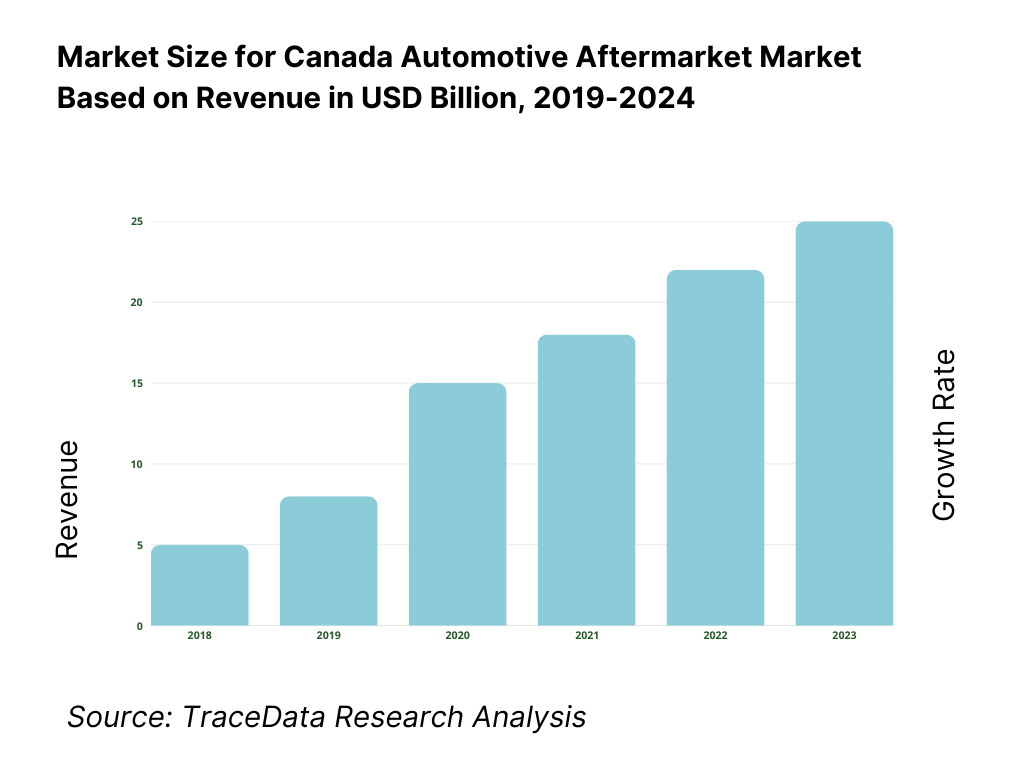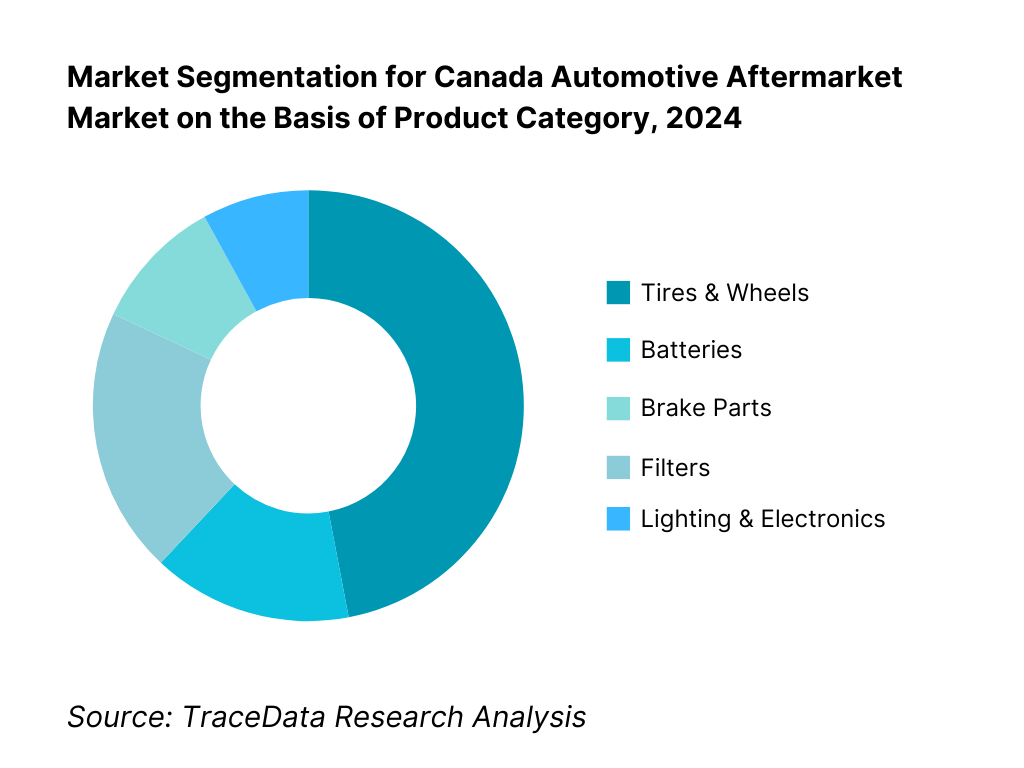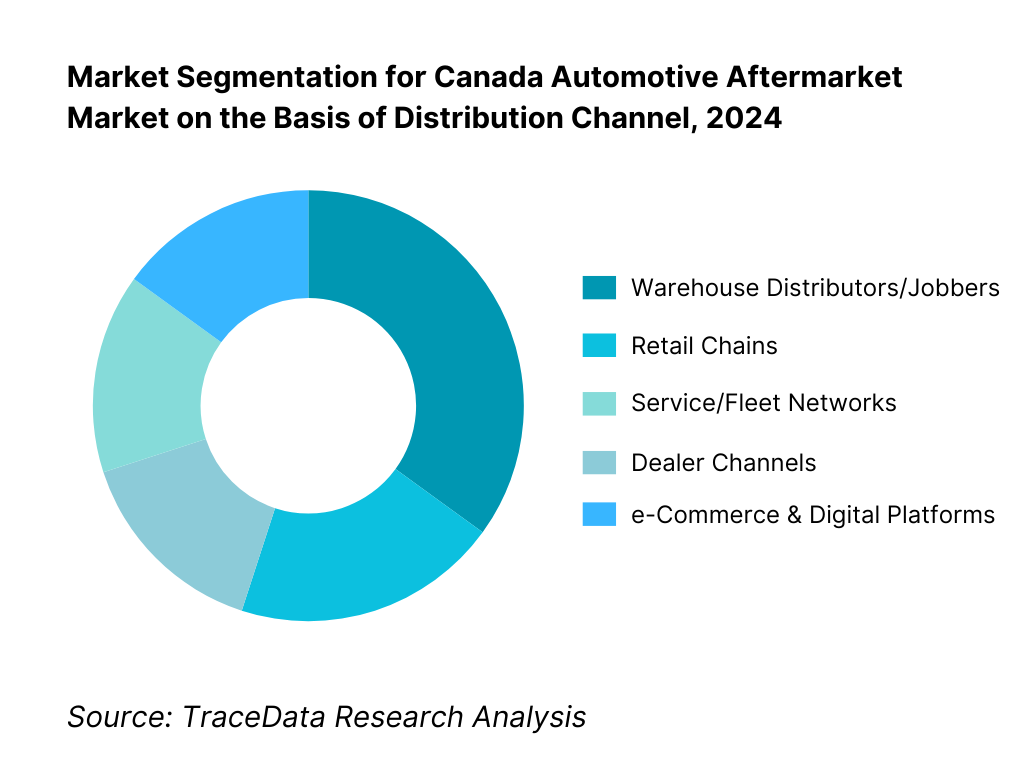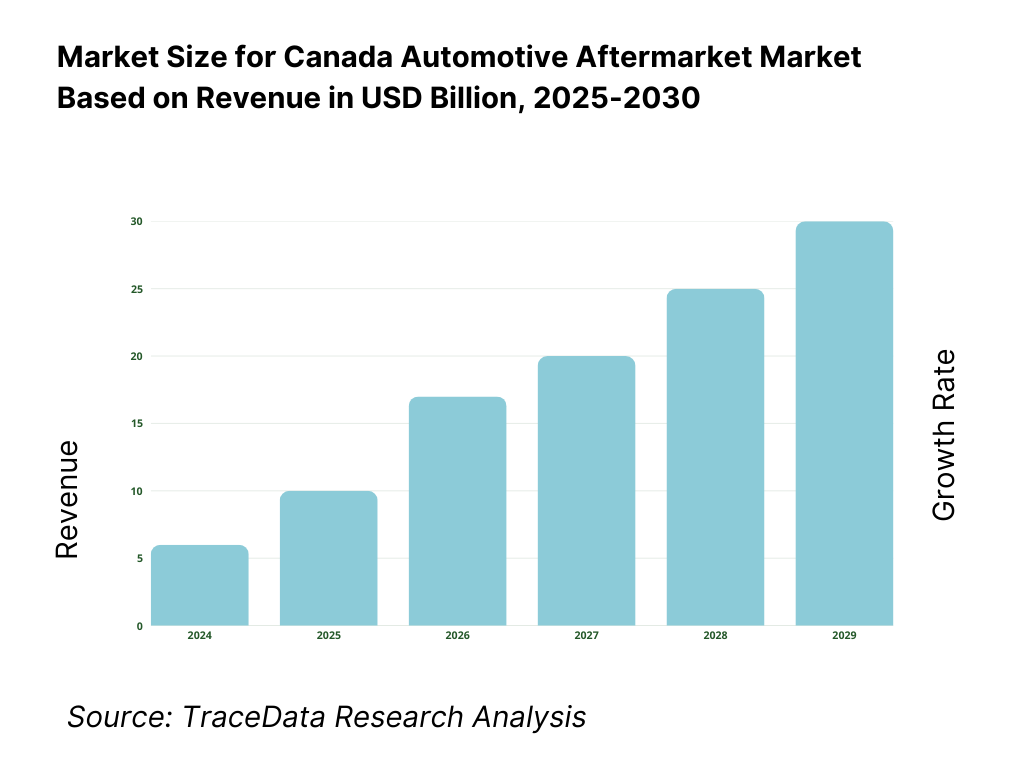Canada Automotive Aftermarket Market Outlook to 2030
By Market Structure, By Product Category, By Distribution Channel, By Service Occasion, By Vehicle/Powertrain, and By Province
- Product Code: TDR0247
- Region: North America
- Published on: August 2025
- Total Pages: 110
Introducing the World's FirstPay-Per-Section Market Reports
Why pay for the full report when you need just a part?
Start Building Your Report
Scroll down to see available sections
Report Summary
The report titled “Canada Automotive Aftermarket Market Outlook to 2030 – By Market Structure, By Product Category, By Distribution Channel, By Service Occasion, By Vehicle/Powertrain, and By Province” provides a comprehensive analysis of the Canadian aftermarket. The study covers the industry’s overview and genesis, overall market size in value terms, and a full segmentation suite: Market Structure; Product Category; Distribution Channel; Service Occasion; Vehicle/Powertrain; and Province. The report details trends and developments, the regulatory landscape, customer-level profiling, and issues & challenges. The competitive landscape maps the competition scenario and includes cross-comparison of leading players, along with detailed company profiles of major distributors, retailers, service banners, collision/glass and tire networks. The report concludes with future market projections to 2029 based on a cause-and-effect model linking vehicle-in-operation cohorts, repair-order volumes, parts/labour mix, channel shifts, EV/ADAS adoption, and provincial growth nodes. Scenario views are provided by product, channel, vehicle/powertrain and province. The closing section presents success case studies and highlights major opportunities and cautions—including technician pipeline strategies, green-parts/reman adoption, private-label architecture, and digitized warranty/core management—that can materially influence outcomes for operators and investors.
Canada Automotive Aftermarket Market Overview and Size
The Canadian automotive aftermarket is valued at USD 17.3 billion, based on current industry data, and is driven by a historically steady vehicle population, aging out‑of‑warranty vehicles requiring replacement parts and services, and ongoing consumer demand across maintenance, repair, and accessory domains. Additionally, aftermarket revenues benefited in the most recent year from increased spending on seasonal components like tires and batteries. For comparison, in the latest available data, this market climbed to around USD 14.8 billion, reflecting methodological differences among sources; both figures affirm a multi‑billion‑dollar scale driven by VIO and aging vehicles.
Major provinces—especially Ontario, Québec, and Alberta—dominate the aftermarket. These regions host the bulk of Canada’s population, vehicle registrations, and service infrastructures (repair shops, jobbers, tire chains, etc.). Ontario, in particular, leads due to its dense urban centers, extensive vehicle parc, and cold‑weather seasonality boosting demand; Québec follows with similar climate‑driven tire and maintenance patterns. Alberta contributes strongly via robust light‑duty vehicle ownership and service networks tied to its broader economic base.

What Factors are Leading to the Growth of the Canada Automotive Aftermarket Market:
Expanding Vehicle Fleet and Light-Duty Registrations: Canada’s road motor vehicle stock was recorded at 26.3 million registered vehicles in 2022, with light-duty vehicles accounting for approximately 24.1 million units (91.7% of total). This sizeable installed base directly supports aftermarket demand—for maintenance, parts replacement, and service. Furthermore, the ratio of passenger cars stands at 448.842 per 1,000 inhabitants in 2023, indicating a dense vehicle population relative to population—fueling parts and service consumption. The continued growth in light vehicle registrations, which rose even by a modest 0.3% year-on-year in 2022, sustains and potentially accelerates aftermarket needs. These absolute numbers underscore the critical role of vehicle parc growth and density in driving Canada’s automotive aftermarket sector.
Surge in Zero-Emission Vehicle Adoption: Zero-Emission Vehicles (ZEVs)—including BEVs (Battery-Electric Vehicles)—constituted approximately 14.6% of new vehicle registrations in Canada in 2024, equivalent to 270,985 units sold. Among those, BEVs alone numbered 202,103 new registrations, while plug-in hybrids reached 68,882 units. This influx of ZEVs expands demand for specialized aftermarket services—battery care, EV-specific tires, brake systems, and electronic diagnostics. Moreover, ZEVs accounted for one in seven new vehicles sold, reinforcing their growing prominence. Urban centers such as Vancouver, Montreal, and Toronto captured over half of new ZEV registrations in 2023, highlighting regional hubs where demand for EV-specialized aftermarket services will intensify.
Monetary and Fiscal Stability Supporting Consumer Spending: The Canadian macroeconomy exhibited stability: in early 2024, inflation declined from 8.1% in June 2022 to approximately 2.8% by February 2024, aiding consumer confidence and spending ability. Correspondingly, the Bank of Canada reduced its key policy rate to 2.75% by March 2025, following a series of cuts amid moderating inflation and stronger-than-expected GDP—2.6% growth in Q4 of 2024. Lower interest rates reduce financing costs for vehicle maintenance, parts purchases, and repair services, while robust employment growth—over 1.1 million more Canadians employed relative to pre-pandemic levels—fuels discretionary spending on aftermarket services. These macro-financial conditions undergird demand resilience in the aftermarket.
Which Industry Challenges Have Impacted the Growth of the Canada Automotive Aftermarket Market:
EV Registration Volatility and Slow Penetration: While ZEV registrations surged in 2024, there was a notable pullback in early 2025: Q1 saw ZEV share drop to approximately 9.7% of new light-duty registrations, down from 12.5% in Q1 2024, and far below Q4 2024’s 18.9% share. This volatility in EV adoption timing complicates aftermarket planning—especially investments in infrastructure and training for EV/ADAS servicing. Additionally, BEVs in 2023 represented only 1.3% of all vehicles registered on Canadian roads, totaling 329,402 units, limiting the current EV service base. The combination of slow current penetration and short-term fluctuations in adoption rates poses a challenge for aftermarket operators to scale their EV service capabilities reliably.
Trade Uncertainty and External Economic Pressures: Despite internal economic strength, Canada faces external pressures. Trade tensions and U.S. tariff uncertainties have dampened confidence: even though inflation remained near target and GDP grew smartly, policy makers signaled caution in adopting further rate cuts because of fragile business and household sentiment. Moreover, the Bank held interest rates at 2.75% in April 2025, citing instability from potential U.S. protectionist measures and inflation risks from import cost pressures. For the aftermarket, such macroeconomic turbulence can suppress discretionary vehicle care spend and delay investments in servicing infrastructure, especially among small independent operators reliant on consumer confidence and business vehicle spending.
Concentrated Economic Activity and Regional Disparities: Canada’s economic activity is heavily concentrated in populous provinces. Urban centers such as Toronto, Montreal, and Vancouver dominate ZEV adoption and vehicle density, but regions such as the Prairies and Atlantic Provinces lag behind. This concentration creates uneven demand—urban areas require advanced EV/ADAS services, whereas rural or less affluent regions primarily support traditional parts and maintenance. For aftermarket businesses, balancing investments in high-tech service capabilities with geographic demand heterogeneity poses operational and strategic challenges, as ROI timelines differ markedly across regions.
What are the Regulations and Initiatives which have Governed the Market:
ZEV Incentive and Registration Regulations: Canada allows provincial and federal regulation of vehicle registration categories and incentives. In 2024, ZEVs constituted 14.6% of new vehicle sales (around 270,985 units). Provinces like British Columbia and Québec—which account for 92% of new ZEV registrations—offer low electricity rates and generous ZEV purchase incentives, resulting in ZEV shares of 20–30% of new registrants in those provinces. These incentive programs drive the regulatory environment, influencing aftermarket operators to align services (e.g., EV-specific training, calibration) with regional policy landscapes that foster ZEV growth.
Bank of Canada Monetary Policy Affecting Licensing Investment: The Bank of Canada’s policy decisions impact aftermarket service licensing and investment planning. After reducing the policy rate to 2.75% by March 2025, the Bank held the rate steady due to external uncertainties despite strong domestic indicators (inflation near 2%, Q4 GDP growth at 2.6%, improved household spending). Stable borrowing costs can facilitate access to financing for licensing and training—such as for ADAS calibration certifications or EV tooling—but the cautious stance and rate hold implies licensing authorities and businesses must contend with modest financing availability when budgeting regulatory compliance investments.
Vehicle Fleet Aging and Regulatory Maintenance Requirements: Canada’s aging light-duty vehicle fleet—26.3 million registered units in 2022—implies regulation-driven maintenance cycles and licensing of service providers remain pivotal. Provinces enforce inspection and safety standards (e.g., emissions testing, safety certification) that mandate licensed service operations. Although specific inspection regimes vary provincially, they sustain licensing requirements for repair shops. The large vehicle base paired with mandatory regulatory maintenance ensures continued demand for certified service providers, shaping the licensing landscape for aftermarket operations dependent on legal compliance and proper certification.
Canada Automotive Aftermarket Market Segmentation
By Product Category: Tires & Wheels dominate with the largest share. This dominance is due to their high wear rate in Canadian climatic conditions—with frequent winter/summer changes, snow, and road salt—prompting more frequent replacements than other parts. Consumers prioritize tire safety, leading to strong seasonal demand. Major chains and independent stores emphasize tire stocking, promotions, and installation packages, reinforcing tire segment leadership.

By Distribution Channel: Warehouse Distributors/Jobbers lead, accounting for approximately 35% of the channel share. Their dominance stems from deep regional coverage, broad assortments, proximity to independent repair shops, strong logistics, and established relationships with installers. They command loyalty programs and quick-turn delivery, making them indispensable for DIFM service providers.

Competitive Landscape in Canada Automotive Aftermarket Market
The Canadian automotive aftermarket is highly consolidated around a few large distributors and service networks. These major players wield strong channel control, loyalty programs, and national logistics, creating high competitive barriers for smaller operators.
Name | Founding Year | Original Headquarters |
Uni-Select / Bumper to Bumper | 1968 | Boucherville, Québec, Canada |
LKQ Corporation | 1998 | Chicago, USA |
UAP Inc. | 1925 | Montreal, Québec, Canada |
Canadian Tire Corporation | 1922 | Toronto, Ontario, Canada |
PartSource | 1999 | Toronto, Ontario, Canada |
Carquest Canada | 1974 | Toronto, Ontario, Canada |
Lordco Auto Parts | 1974 | Maple Ridge, British Columbia, Canada |
APC Auto Parts Centres | 1981 | London, Ontario, Canada |
Benson Auto Parts | 1953 | Cornwall, Ontario, Canada |
Kal Tire | 1953 | Vernon, British Columbia, Canada |
OK Tire | 1953 | Surrey, British Columbia, Canada |
Fountain Tire | 1956 | Edmonton, Alberta, Canada |
Mr. Lube Canada | 1976 | Richmond, British Columbia, Canada |
Midas Canada | 1964 | Toronto, Ontario, Canada |
CARSTAR Canada | 1995 | Hamilton, Ontario, Canada |
Fix Network Canada | 1992 | Blainville, Québec, Canada |
Belron Canada | 1999 | Montreal, Québec, Canada |
Some of the Recent Competitor Trends and Key Information About Competitors Include:
Uni-Select / LKQ (Bumper to Bumper): Following LKQ’s acquisition of Uni-Select, the combined entity has been streamlining operations in Canada. In 2024, the company invested heavily in expanding its distribution centers and integrating IT systems, ensuring faster parts delivery and strengthening banner programs across independent repair shops.
UAP Inc. (NAPA Auto Parts): NAPA has focused on enhancing its NAPA AUTOPRO service network, adding new outlets across Ontario and Québec. The company also rolled out advanced e-commerce ordering capabilities for installers in 2024, improving real-time inventory visibility and same-day delivery options.
Canadian Tire / PartSource: Canadian Tire Automotive Services expanded its tire and maintenance packages, with PartSource stores enhancing DIY product offerings. In 2024, the company integrated digital booking tools across its service bays, driving convenience for consumers and capturing higher DIFM demand.
Carquest Canada (Advance Auto Parts): Carquest strengthened partnerships with independent jobbers and rolled out improved training programs for service shop technicians. In 2024, it also upgraded its B2B platform for garages, focusing on faster parts lookup and warranty integration.
Kal Tire: Kal Tire continues to lead in Canada’s tire aftermarket, especially in winter tire sales and commercial OTR segments. In 2024, the company expanded its retreading operations and introduced EV tire service training programs, positioning itself for the growing electric vehicle parc.

What Lies Ahead for Canada Automotive Aftermarket Market?
The Canada automotive aftermarket is set to expand steadily through the next planning horizon, supported by a large and aging vehicle-in-operation base, consistent kilometers-driven in commuter and fleet segments, and rising out-of-warranty volumes flowing from recent new-vehicle sales. Momentum will be reinforced by winter-season tire/battery demand, sustained insurer-directed collision work, and the gradual build-out of EV/ADAS service capacity. Consolidation among warehouse distributors, collision MSOs, and tire/service banners will further professionalize pricing, logistics, and installer programs, underpinning multi-year revenue stability.
Rise of Hybrid Service & Fulfillment Models: Service delivery will increasingly blend in-bay visits with mobile units, pickup/drop-off, and online-to-offline (O2O) scheduling. Parts fulfillment will shift to true omnichannel: VIN-resolved e-ordering, real-time stock visibility, and same-day runs from micro-fulfillment nodes or dark stores attached to high-volume outlets. Quick-service formats will add tires, brakes, and light mechanical, while traditional independents adopt digital vehicle inspections (DVI) and remote approvals, raising approval rates and average repair orders without adding bays.
Shift to Outcome-Based Service & Warranty KPIs: Installers, fleets, and insurers will anchor partnerships on measurable outcomes—first-time-fix, comeback rates, ADAS calibration success, cycle time, and customer lifetime value. Banners and WDs will differentiate via uptime guarantees, delivery-run SLAs, extended-kilometer warranties, and analytics-driven maintenance plans. Expect tighter warranty adjudication, standardized core/return handling, and technician productivity dashboards that link training badges to bay efficiency and gross profit per hour.
Expansion of Segment-Specific Service Lines (EV/ADAS/Commercial): Specialized revenue pools will scale: EV tire fitments and brake service, high-voltage battery conditioning, thermal management, and glass plus camera/radar calibration. Collision networks will co-locate calibration centers; tire franchises will broaden into suspension and steering for heavier crossovers and light trucks. Commercial and last-mile fleets will drive contracted maintenance, on-site service windows, and bulk parts programs, while recycled and remanufactured “green parts” gain share under EPR and sustainability mandates.
AI, Telematics & Analytics-Led Aftermarket: AI will power VIN-level parts accuracy, demand forecasting, and dynamic routing for multi-run delivery days. Telematics will trigger predictive maintenance tickets and push quotes to fleet portals; computer vision from DVIs will auto-build estimates and recommend parts bundles. Pricing engines will balance OEM/OES/Aftermarket mix and private-label margins, while workforce tools match jobs to certified technicians and surface just-in-time training for EV and ADAS procedures—raising bay utilization and customer satisfaction.

Canada Automotive Aftermarket Market Segmentation
By Product Category
Tires & Wheels
Batteries
Brake Parts
Filters
Lighting & Electronics
Turbochargers & Exhaust
Lubricants & Chemicals
Body & Collision Parts
By Distribution Channel
Warehouse Distributors / Jobbers
Retail Chains
Service / Fleet Networks
Dealer Channels
e-Commerce & Digital Platforms
By Vehicle Category / Usage
Passenger Cars
Light Trucks & SUVs
Medium & Heavy-Duty Vehicles
Off-Highway / Power Sports
Commercial Fleets
By Consumer Type
DIY
DIFM Independent
DIFM Dealer
Fleet / Commercial
Insurance-Directed
By Powertrain Type
ICE Gasoline
ICE Diesel
Hybrid (HEV)
Plug-in Hybrid
Battery Electric Vehicle
By Region / Province
Ontario
Quebec
British Columbia
Prairies
Atlantic Canada & Northern regions
Players Mentioned in the Report:
Uni-Select / Bumper to Bumper
UAP Inc. / NAPA Auto Parts
Canadian Tire / PartSource
Carquest Canada (Advance Auto Parts)
Lordco Auto Parts
APC Auto Parts Centres
Benson Auto Parts
Kal Tire
OK Tire
Fountain Tire
Mr. Lube
Midas Canada
CARSTAR Canada
Fix Network Canada
Belron Canada
Key Target Audience
National and Regional Warehouse Distributors & Jobber Executives
Retail Chain Operations Heads (e.g., Canadian Tire leadership)
Major Vehicle Fleet Managers (logistics and commercial fleets)
Insurer & DRP Program Directors
EV & ADAS Calibration Center Owners/Operators
Private Equity & Investment Firms focused on automotive retail/service sectors
Government and Regulatory Bodies (Transport Canada, AIA Canada)
Large Vehicle Leasing & Rental Companies
Time Period:
Historical Period: 2019-2024
Base Year: 2025
- Forecast Period: 2025-2030
Report Coverage
Choose individual sections to purchase. Mix and match as you like.
- -
- -
(OEMs, OES, WDs/Jobbers, Buying Groups, Retail Chains, Service Banners, Collision/Glass Networks, Tire Specialists, Recyclers, Insurers, Fleets, Regulators, eCommerce Platforms)
$1004.1. Delivery Model Analysis-DIFM vs DIY vs Dealer vs Fleet (Margins, Customer Preference, Strengths & Weaknesses)
4.2. Revenue Streams-Parts, Labour, Tires, Glass, Chemicals, Accessories, Warranty Claims, Digital Add-ons
4.3. Business Model Canvas-Distribution, Service, Collision/Glass, Tire Networks, Online B2B/B2C Platforms
$2505.1. Independent Repair vs Dealer Service vs Quick Lubes/Tire Chains vs Collision/Glass Specialists
5.2. Investment Model-DCs, Calibration Centres, Technology Platforms, Buying Group Expansion
5.3. Comparative Analysis of Service Funnel-Warranty Expiry †’ Independent vs Dealer Capture †’ Fleet/Insurance DRP Allocation
5.4. Repair & Maintenance Spend Allocation by Vehicle Age and Fleet/Personal Use
$150(Channel Maturity | Competitive Intensity | Growth Hotspots | EV & ADAS Opportunity Pockets)
$100(Technician Shortage, Bay Capacity Utilization, Seasonal Tire Peaks, Parts Fill Rates, ADAS Calibration Bottlenecks)
$2008.1. Revenues (Historical Market Value, Growth Trajectory)
$3009.1. By Market Structure (Independent DIFM, Dealer DIFM, DIY, Fleet/Insurance Driven, Online Aftermarket)
9.2. By Product Category (Maintenance, Mechanical, Collision/Refinish, Tires & Wheels, Chemicals & Lubes)
9.3. By Vehicle Parc (Passenger Cars, Light Trucks/SUVs, Medium/Heavy Duty, Off-Highway, Fleets)
9.3.1. Passenger Cars Service Mix
9.3.2. Light Truck & SUV Service Mix
9.3.3. Medium & Heavy Duty Vehicle Service Mix
9.3.4. Fleet & Commercial Accounts Service Mix
9.4. By Consumer Type (DIY vs DIFM vs Fleet vs Insurance-Directed)
9.5. By Powertrain (ICE Gasoline, ICE Diesel, Hybrid, PHEV, BEV)
9.6. By Service Occasion (Maintenance, Repairs, Collision/Glass, Tires, Accessories)
9.7. By Distribution Channel (Warehouse Distributors/Jobbers, Retail Chains, eCommerce, Service Networks, Dealer Channel)
9.8. By Region/Province (Ontario, Québec, BC, Prairies, Atlantic, Northern)
$40010.1. Vehicle Owner Segmentation and Cohort Analysis (Fleet, DIY, Urban DIFM, Rural DIFM)
10.2. Service & Parts Purchase Decision-Making Process (Brand/Price/Availability/Warranty)
10.3. Program Effectiveness & ROI Analysis (Banners, Loyalty, Fleet Programs, Insurance DRPs)
10.4. Gap Analysis Framework (Unmet Needs, Right-to-Repair Access, EV/ADAS Service Gaps)
$50011.1. Trends & Developments (Digital Workflows, eCommerce, EV/ADAS Service Growth, Consolidation, Same-Day Delivery)
11.2. Growth Drivers (VIO, Average Vehicle Age, Warranty Expiry, Tire/Winter Regulations, DIY/DIFM Shifts, EV Policies)
11.3. SWOT Analysis (Independent Channel Strength vs OEM Control, Tech Adoption vs Labour Gaps)
11.4. Issues & Challenges (Technician Shortage, Right-to-Repair Enforcement, Core/Environmental Fees, Rural Coverage Gaps)
11.5. Government Regulations (CASIS, Right-to-Repair, EV Availability Standard, Provincial Safety Inspections, Winter Tire Mandates, Technician Certification, Environmental Standards)
$20012.1. Market Size & Future Potential (B2B Ordering, B2C eRetail, Fleet Portals)
12.2. Business Model & Revenue Streams (Marketplace, Direct-to-Installer, Subscription Platforms)
12.3. Delivery Models (Same-Day, Last-Mile, Click & Collect, In-Shop Delivery)
12.4. Cross-Comparison of Leading Online Aftermarket Companies (Assortment, Revenue, Installer Reach, SKU Breadth, Pricing, Logistics Network, EV/ADAS Readiness, Warranty Support)
$500(Channel Hotspots, EV Service Readiness, ADAS Calibration, Fleet Partnerships, eCommerce Adoption)
$250(Installer Network Coverage, Logistics Efficiency, Digital Platform Maturity, OEM/OES Dependence, EV Transition Readiness)
$15015.1. Market Share of Key Players (Independent WD, Retail, Tire, Collision/Glass, Quick Service, Dealer)
15.2. Benchmark of Key Competitors (Company Overview, USP, Strategy, Distribution Network, SKU Coverage, Number of Branches, Revenues, Technology Use, Major Clients, Strategic Tie-ups, Marketing Strategy, Recent Developments)
15.3. Operating Model Analysis Framework (DC Utilization, Delivery Runs, Installer Programs, Warranty Management)
15.4. Gartner Magic Quadrant (Market Leaders, Challengers, Visionaries, Niche)
15.5. Bowmans Strategic Clock (Competitive Advantage Mapping: Cost Leadership, Differentiation, Focused Plays)
$75016.1. Revenues (Projections under Base, High, Low Scenarios)
$30017.1. By Market Structure (Independent, Dealer, Fleet/Insurance, DIY, Online)
17.2. By Product Category (Maintenance, Mechanical, Collision/Refinish, Tires, Chemicals/Lubes)
17.3. By Vehicle Parc (Passenger, Light Truck/SUV, Medium/Heavy Duty, Fleet)
17.3.1. Passenger Cars Service Projections
17.3.2. Light Truck & SUV Service Projections
17.3.3. Medium & Heavy Duty Service Projections
17.3.4. Fleet & Commercial Service Projections
17.4. By Consumer Type (DIY, DIFM, Fleet, Insurance-Directed)
17.5. By Powertrain (ICE, Hybrid, PHEV, BEV)
17.6. By Service Occasion (Maintenance, Repairs, Collision/Glass, Tires, Accessories)
17.7. By Distribution Channel (WD/Jobber, Retail, eCommerce, Service Networks, Dealer)
17.8. By Region/Province (Ontario, Québec, BC, Prairies, Atlantic, Northern)
$400- $250
- $250
Research Methodology
Step 1: Ecosystem Creation
We begin by mapping the full ecosystem of the Canada Automotive Aftermarket, covering both demand-side and supply-side entities. On the demand side, this includes independent repair shops, dealer service centers, quick lube & tire chains, collision & glass networks, commercial fleets, insurers, and DIY consumers. On the supply side, the ecosystem includes warehouse distributors, jobbers, buying groups, parts manufacturers, banner networks, digital marketplaces, and recycler/remanufacturers. Based on this mapping, we shortlist 5–6 leading market participants—such as Uni-Select/LKQ, UAP/NAPA, Canadian Tire, Kal Tire, Belron Canada, and Fix Network—using filters like financial disclosures, national distribution coverage, and installer/client base. Sourcing is conducted through industry association publications (e.g., AIA Canada), Statistics Canada’s automotive datasets, and multiple secondary/proprietary databases to collate market-level insights.
Step 2: Desk Research
We conduct exhaustive desk research by referencing secondary and proprietary databases to build a foundation of industry-level analysis. This includes collating data on variables such as the number of registered vehicles in operation, kilometers driven, average vehicle age, aftermarket revenue pools, and service bay density across provinces. At the company level, we examine annual reports, press releases, regulatory filings, investor presentations, and media coverage to extract data on distribution footprints, branch locations, delivery run frequency, and fleet contracts. This stage enables construction of a baseline view of the market and the operational frameworks of major competitors.
Step 3: Primary Research
We supplement desk research with in-depth interviews of C-level executives, regional managers, banner program leaders, parts manufacturers, and fleet/insurance decision-makers. These structured interactions serve three purposes:
Validate hypotheses formed during desk research.
Authenticate statistical data on installer networks, logistics KPIs, and revenue breakdowns.
Extract operational and financial insights, such as technician shortages, parts fill rates, and warranty claim trends.
To enhance validation, our team occasionally conducts disguised interviews, approaching companies as potential clients. This method helps cross-check operational claims (e.g., same-day delivery runs or installer rebates) against secondary data. Interviews also clarify revenue streams (parts, tires, collision), value chain processes, cost recovery structures, and margin frameworks.
Step 4: Sanity Check
We undertake bottom-up and top-down triangulation to confirm the reliability of estimates. The bottom-up approach aggregates data from repair order volumes, average repair order values, and service occasions by channel, while the top-down approach reconciles this with macro-level indicators like total registered vehicles and per-vehicle maintenance spend. Advanced market size modeling exercises are applied to ensure consistency between distributor-level revenues and aggregated aftermarket value pools. This dual approach provides a validated and accurate picture of the Canadian automotive aftermarket.
FAQs
01 What is the potential for the Canada Automotive Aftermarket Market?
The Canada Automotive Aftermarket Market is poised for steady expansion, reaching a valuation of USD [X] Billion in 2024. Growth is propelled by a large and aging vehicle-in-operation base, recurring maintenance demand (tires, batteries, brakes), and strong DIFM volumes from fleets and insurer-directed repairs. Digitalization—VIN-resolved e-ordering, real-time inventory, and same-day delivery—raises fulfillment efficiency, while EV/ADAS adoption unlocks new service lines such as calibration and high-voltage battery care. Consolidation across warehouse distributors, collision MSOs, and tire/service banners further professionalizes pricing, logistics, and installer programs.
02 Who are the Key Players in the Canada Automotive Aftermarket Market?
The Canada Automotive Aftermarket Market features several key players, including LKQ/Uni-Select (Bumper to Bumper), UAP Inc. (NAPA Auto Parts/NAPA AUTOPRO), Canadian Tire/PartSource, and Carquest (Advance Auto Parts). These organizations dominate due to national distribution footprints, deep installer networks, and robust private-label portfolios. Other notable players include Lordco Auto Parts, APC Auto Parts Centres, Benson Auto Parts, Kal Tire, OK Tire, Fountain Tire, Mr. Lube, Midas Canada, CARSTAR Canada, Fix Network Canada (Fix Auto/ProColor/Speedy Auto Service/NOVUS Glass), and Belron Canada (Speedy Glass/Lebeau/Apple Auto Glass/Broco).
03 What are the Growth Drivers for the Canada Automotive Aftermarket Market?
Primary growth drivers include a sizable, aging vehicle-in-operation base that consistently generates maintenance and repair occasions; cold-weather seasonality that boosts demand for tires, batteries, fluids, and undercar components; and expanding fleet and insurer channels that funnel steady RO volumes into independent banners and MSOs. Digital transformation—B2B portals, e-commerce, and route-optimized last-mile delivery—improves parts availability and bay productivity. In parallel, the ramp-up of EV/ADAS platforms creates specialized revenue pools in calibration, thermal management, and EV-specific tires and braking systems.
04 What are the Challenges in the Canada Automotive Aftermarket Market?
Key challenges include a persistent technician shortage and training gaps for EV and ADAS procedures, which constrain bay capacity and first-time-fix rates; data access and calibration complexity tied to modern electronics and right-to-repair enforcement, raising tooling and certification costs; and continued margin pressure from parts inflation, returns/core management, and competitive pricing across omnichannel retail. Geographic dispersion and regional demand disparities add to operating complexity, requiring tailored assortment, delivery frequency, and banner program support across provinces and urban versus rural markets.